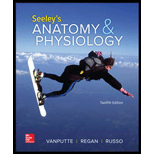
If a splinter penetrates the skin of the palm of the hand to the second epidermal layer from the surface, the last layer damaged is the
a. stratum granulosum. d. stratum
b. stratum basale. e. stratum spinosum.
c. stratum corneum.
Introduction:
The skin is comprised of 2 major tissue layers, the epidermis and the dermis. The epidermis is the superficial skin layer, comprising stratified epithelial squamous tissue. The multiple cell layers of the epidermis protects against the potential damage from abrasion on the skin's surface.
Answer to Problem 1RAC
The correct answer is option (d) stratum lucidum.
Explanation of Solution
Explanation/justification for the correct answer:
Option (d) stratum lucidum. The stratum lucidum in the epidermis is a thin, transparent layer of dead skin cells named for its translucent appearance under a microscope. It is easily noticeable by light microscopy only in regions of thick skin found on the hands ' palms and feet's soles. So, the correct answer is option (d).
Explanation for incorrect answer:
Option (a) stratum granulosum. A thin layer of cells in the epidermis is the stratum granulosum (or granular layer). Keratinocytes that migrate from the underlying stratum spinosum are known in this layer as granular cells. So, this is an incorrect option.
Option (b) stratum basale. The stratum basale is the deepest layer of the five layers of the epidermis, which cover the outside of the skin in mammals and is sometimes called as the stratum germinativum. So, this is an incorrect option.
Option (c) stratum corneum. Stratum corneum is the peripheral layer of the skin, comprising of keratinized cells. The stratum corneum, or the skin boundary, goes about as our first line of resistance against the outer condition. It is a compact layer of cells and lipids that has two basic capacities: it shields our bodies from microorganisms, UV harm and other assaults; and avoids natural moisture from escaping, to keep skin hydrated. So, this is an incorrect option.
Option (e) stratum spinosum. Stratum spinosum is a superficial stratum basale which consists of 8 to10 layers of multi-sided cells. As the cells in this stratum are pushed to the ground, they flattened; desmosomes break apart and fresh desmosomes form. So this is an incorrect option.
If a splinter penetrates the skin of the palm of the hand to the second epidermal layer from the surface, the last layer damaged is the stratum lucidum. Hence, the correct answer is option (d) small intestine.
Want to see more full solutions like this?
Chapter 5 Solutions
Seeley's Anatomy & Physiology
- Which of the following is not true about the life-cycle of Fucus. a. 8 eggs per oogonium b. 64 sperm per antheridium c. eggs are flagellated d. sperm are flagellatedarrow_forwardGreen Algae, as a group, is actually paraphyletic with one subgroup more closely related to higher plants than the other. Which of the following green algae groups is more closely related to higher plants: a. Charophyceans b. Chlorophyceans c. Rhodophyta d. Xanthophyceansarrow_forwardCertain toxic terpenoids in this group is thought to deter herbivory but may also have some anti-tumor activity? a. green algae b. brown algae c. red algae d. golden algae e. none of thesearrow_forward
- In the cellular slime molds, the most common phase is: a. plasmodium b. pseudoplasmodial c. single cells as myxamoebae d. moundingarrow_forwardWhich of the following descriptive terms does not describe Hydrodictyon? a. colonial b. nonmotile c. 1 large reticulated chloroplast in each cell d. all of these describe Hydrodictyonarrow_forwardWhich of the following does not apply to Chara? a. "stoneworts" b. isogamous c. calcified walls d. apical growth with an axis and branchesarrow_forward
 Anatomy & PhysiologyBiologyISBN:9781938168130Author:Kelly A. Young, James A. Wise, Peter DeSaix, Dean H. Kruse, Brandon Poe, Eddie Johnson, Jody E. Johnson, Oksana Korol, J. Gordon Betts, Mark WomblePublisher:OpenStax College
Anatomy & PhysiologyBiologyISBN:9781938168130Author:Kelly A. Young, James A. Wise, Peter DeSaix, Dean H. Kruse, Brandon Poe, Eddie Johnson, Jody E. Johnson, Oksana Korol, J. Gordon Betts, Mark WomblePublisher:OpenStax College
 Human Biology (MindTap Course List)BiologyISBN:9781305112100Author:Cecie Starr, Beverly McMillanPublisher:Cengage Learning
Human Biology (MindTap Course List)BiologyISBN:9781305112100Author:Cecie Starr, Beverly McMillanPublisher:Cengage Learning





